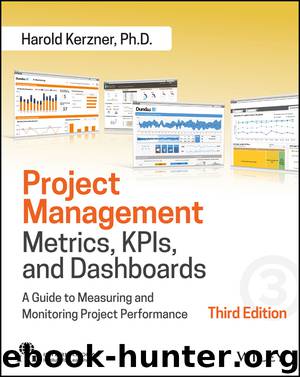Project Management Metrics, KPIs, and Dashboards by Harold Kerzner

Author:Harold Kerzner
Language: eng
Format: epub
ISBN: 9781119427322
Publisher: Wiley
Published: 2017-08-23T00:00:00+00:00
Today, these types of projects focus more on value than on the competing constraints. Value-driven constraints emphasize stakeholder satisfaction and decisions and the value that is expected on the project. In others words, success is when the value is obtained, it is hoped within the triple or competing constraints. As a result, we can define the four cornerstones of success using Figure 5.2.
Figure 5.2 Four Cornerstones of Success
Very few projects are completed without some trade-offs. Metrics provide some of the necessary information needed for decisions on trade-offs. This holds true for both the traditional projects and those that are based on value components and metrics. Traditional trade-offs result in a lengthening of the schedule and an increase in the budget. The same holds true for the value-driven projects, but the major difference is with performance. With traditional trade-offs, performance tends to be reduced to satisfy other requirements. With value-driven projects, performance tends to be increased in hopes of providing added value, and this tends to cause much larger cost overruns and schedule slippages than with traditional trade-offs. The amount of additional time and funding that the stakeholders will allow is dependent on the tracking of the metrics.
Projects managers generally do not have the sole authority for scope or performance increases or decreases. For traditional trade-offs, the project manager and the project sponsor, working together, may have the authority to make trade-off decisions.
However, for value-driven projects, all or most of the stakeholders may need to be involved. This can create additional issues such as:
It may not be possible to get all of the stakeholders to agree on a value target during project initiation.
It may not be possible to get all of the stakeholders to agree on the metrics or KPIs.
Getting agreement on scope changes, extra costs, and schedule extensions is significantly more difficult the farther along the project is.
Stakeholders must be informed of the value expected from the project at project initiation and continuously briefed as the project progresses; that is, no surprises!
Download
This site does not store any files on its server. We only index and link to content provided by other sites. Please contact the content providers to delete copyright contents if any and email us, we'll remove relevant links or contents immediately.
| Automotive | Engineering |
| Transportation |
Whiskies Galore by Ian Buxton(40330)
Introduction to Aircraft Design (Cambridge Aerospace Series) by John P. Fielding(32338)
Small Unmanned Fixed-wing Aircraft Design by Andrew J. Keane Andras Sobester James P. Scanlan & András Sóbester & James P. Scanlan(32141)
Craft Beer for the Homebrewer by Michael Agnew(17446)
Turbulence by E. J. Noyes(7039)
The Complete Stick Figure Physics Tutorials by Allen Sarah(6638)
Kaplan MCAT General Chemistry Review by Kaplan(6053)
The Thirst by Nesbo Jo(5785)
Bad Blood by John Carreyrou(5769)
Learning SQL by Alan Beaulieu(5411)
Weapons of Math Destruction by Cathy O'Neil(5036)
Man-made Catastrophes and Risk Information Concealment by Dmitry Chernov & Didier Sornette(4735)
iGen by Jean M. Twenge(4702)
Digital Minimalism by Cal Newport;(4540)
Life 3.0: Being Human in the Age of Artificial Intelligence by Tegmark Max(4507)
Audition by Ryu Murakami(4099)
1,001 ASVAB Practice Questions For Dummies by Powers Rod(4038)
Electronic Devices & Circuits by Jacob Millman & Christos C. Halkias(4027)
Pale Blue Dot by Carl Sagan(4001)
